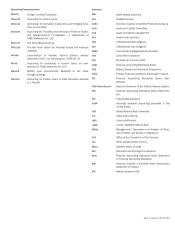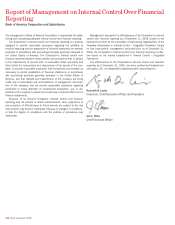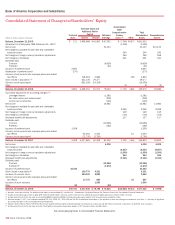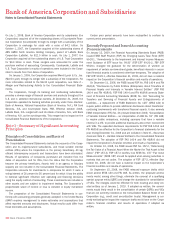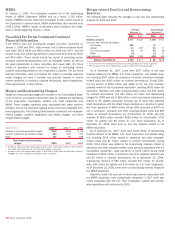Bank of America 2008 Annual Report Download - page 124
Download and view the complete annual report
Please find page 124 of the 2008 Bank of America annual report below. You can navigate through the pages in the report by either clicking on the pages listed below, or by using the keyword search tool below to find specific information within the annual report.Collateral
The Corporation accepts collateral that it is permitted by contract or cus-
tom to sell or repledge. At December 31, 2008, the fair value of this col-
lateral was approximately $144.5 billion of which $117.6 billion was sold
or repledged. At December 31, 2007, the fair value of this collateral was
approximately $210.7 billion of which $156.3 billion was sold or
repledged. The primary source of this collateral is reverse repurchase
agreements. The Corporation also pledges securities and loans as collat-
eral in transactions that include repurchase agreements, public and trust
deposits, U.S. Treasury Department (U.S. Treasury) tax and loan notes,
and other short-term borrowings. This collateral can be sold or repledged
by the counterparties to the transactions.
In addition, the Corporation obtains collateral in connection with its
derivative activities. Required collateral levels vary depending on the
credit risk rating and the type of counterparty. Generally, the Corporation
accepts collateral in the form of cash, U.S. Treasury securities and other
marketable securities. Based on provisions contained in legal netting
agreements, the Corporation has netted cash collateral against the appli-
cable derivative mark-to-market exposures. Accordingly, the Corporation
offsets its obligation to return or its right to reclaim cash collateral
against the fair value of the derivatives being collateralized. The Corpo-
ration also pledges collateral on its own derivative positions which can be
applied against derivative liabilities.
Trading Instruments
Financial instruments utilized in trading activities are stated at fair value.
Fair value is generally based on quoted market prices or quoted market
prices for similar assets and liabilities. If these market prices are not
available, fair values are estimated based on dealer quotes, pricing
models, discounted cash flow methodologies, or similar techniques for
which the determination of fair value may require significant management
judgment or estimation. Realized and unrealized gains and losses are
recognized in trading account profits (losses).
Derivatives and Hedging Activities
The Corporation designates a derivative as held for trading, an economic
hedge not designated as a SFAS No. 133, “Accounting for Derivative
Instruments and Hedging Activities, as amended” (SFAS 133) hedge, or a
qualifying SFAS 133 hedge when it enters into the derivative contract. The
designation may change based upon management’s reassessment or
changing circumstances. Derivatives utilized by the Corporation include
swaps, financial futures and forward settlement contracts, and option
contracts. A swap agreement is a contract between two parties to
exchange cash flows based on specified underlying notional amounts,
assets and/or indices. Financial futures and forward settlement contracts
are agreements to buy or sell a quantity of a financial instrument, index,
currency or commodity at a predetermined future date, and rate or price.
An option contract is an agreement that conveys to the purchaser the
right, but not the obligation, to buy or sell a quantity of a financial instru-
ment (including another derivative financial instrument), index, currency or
commodity at a predetermined rate or price during a period or at a time in
the future. Option agreements can be transacted on organized exchanges
or directly between parties. The Corporation also provides credit
derivatives to customers who wish to increase or decrease credit
exposures. In addition, the Corporation utilizes credit derivatives to
manage the credit risk associated with the loan portfolio.
All derivatives are recognized on the Consolidated Balance Sheet at
fair value, taking into consideration the effects of legally enforceable
master netting agreements that allow the Corporation to settle positive
and negative positions and offset cash collateral held with the same
counterparty on a net basis. For exchange-traded contracts, fair value is
based on quoted market prices. For non-exchange traded contracts, fair
value is based on dealer quotes, pricing models, discounted cash flow
methodologies, or similar techniques for which the determination of fair
value may require significant management judgment or estimation.
Valuations of derivative assets and liabilities reflect the value of the
instrument including the values associated with counterparty risk. With
the issuance of SFAS 157, these values must also take into account the
Corporation’s own credit standing, thus including in the valuation of the
derivative instrument the value of the net credit differential between the
counterparties to the derivative contract. Effective January 1, 2007, the
Corporation updated its methodology to include the impact of both the
counterparty and its own credit standing.
Prior to January 1, 2007, the Corporation recognized gains and losses
at inception of a derivative contract only if the fair value of the contract
was evidenced by a quoted market price in an active market, an
observable price or other market transaction, or other observable data
supporting a valuation model in accordance with EITF Issue No. 02-3,
“Issues Involved in Accounting for Derivative Contracts Held for Trading
Purposes and Contracts Involved in Energy Trading and Risk Management
Activities” (EITF 02-3). For those gains and losses not evidenced by the
above mentioned market data, the transaction price was used as the fair
value of the derivative contract. Any difference between the transaction
price and the model fair value was considered an unrecognized gain or
loss at inception of the contract. These unrecognized gains and losses
were recorded in income using the straight-line method of amortization
over the contractual life of the derivative contract. The adoption of SFAS
157 on January 1, 2007, eliminated the deferral of these gains and
losses resulting in the recognition of previously deferred gains and losses
as an increase to the beginning balance of retained earnings by a pre-tax
amount of $22 million.
Trading Derivatives and Economic Hedges
The Corporation designates at inception whether the derivative contract is
considered hedging or non-hedging for SFAS 133 accounting purposes.
Derivatives held for trading purposes are included in derivative assets or
derivative liabilities with changes in fair value reflected in trading account
profits (losses).
Derivatives used as economic hedges but not designated in a hedging
relationship for accounting purposes are also included in derivative
assets or derivative liabilities. Changes in the fair value of derivatives that
serve as economic hedges of mortgage servicing rights (MSRs), IRLCs
and first mortgage loans held-for-sale (LHFS) that are originated by the
Corporation are recorded in mortgage banking income. Changes in the fair
value of derivatives that serve as asset and liability management (ALM)
economic hedges, which do not qualify or were not designated as
accounting hedges, are recorded in other income (loss). Credit derivatives
used by the Corporation do not qualify for hedge accounting under SFAS
133 despite being effective economic hedges and changes in the fair
value of these derivatives are included in other income (loss).
Derivatives Used For SFAS 133 Hedge Accounting Purposes
For SFAS 133 hedges, the Corporation formally documents at inception
all relationships between hedging instruments and hedged items, as well
as its risk management objectives and strategies for undertaking various
accounting hedges. Additionally, the Corporation uses dollar offset or
regression analysis at the hedge’s inception and for each reporting period
thereafter to assess whether the derivative used in its hedging trans-
action is expected to be and has been highly effective in offsetting
changes in the fair value or cash flows of the hedged item. The Corpo-
122
Bank of America 2008



